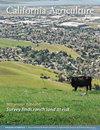放牧和除草剂应用的结合改善了牧场和牧场对倒钩山羊草和水母的管理
IF 1.2
4区 农林科学
Q2 AGRICULTURE, MULTIDISCIPLINARY
引用次数: 1
摘要
入侵的一年生禾草有刺山羊草(Aegilops triuncialis L.)和水母草(Elymus caput-medusae L.)在西部各州广泛存在,给草原管理带来了挑战。为了制定对这些物种的综合管理策略,我们对门多西诺县的五个牧场进行了处理,比较了集约放牧、草甘膦除草剂(低剂量和高剂量)和施用时间(分蘖期、靴期和抽穗期)的组合。我们发现,单独放牧使倒刺山羊草的小穗密度降低68%,每个小穗的种子数降低35%。两种不放牧草甘膦施用量对种子产量的影响相似。分蘖期高剂量和低剂量的草甘膦施用几乎完全控制了两种目标物种。启动期和抽穗期施用分别使倒刺山羊草密度降低39%和32%。在孕穗期施用也导致每穗山羊草种子数量减少82%。我们的研究结果表明,集约放牧可能是一种有效的管理策略,可以减少倒刺山羊草和梅杜斯前期的小穗密度和倒刺山羊草种子数量,特别是在孕穗期或抽穗期施用草甘膦的情况下。本文章由计算机程序翻译,如有差异,请以英文原文为准。
Integration of grazing and herbicide application improves management of barb goatgrass and medusahead in pasture and rangelands
The invasive annual grasses barb goatgrass (Aegilops triuncialis L.) and medusahead (Elymus caput-medusae L.) are widespread in western states and present management challenges on grasslands. To develop an integrated management strategy for these species, we treated sites in five pastures in Mendocino County, comparing combinations of intensive sheep grazing, glyphosate herbicide (low and high), and application timings (tillering, boot and heading stage). We found that grazing alone reduced barb goatgrass spikelet densities by 68% and the number of seeds per spikelet by 35%. Both rates of glyphosate application without grazing had similar effects on seed production. High and low glyphosate application at tillering resulted in almost complete control of both target species. Boot- and heading-stage applications reduced barb goatgrass density by 39% and 32%, respectively. Application at the boot stage also resulted in an 82% reduction in number of seeds per barb goatgrass spikelet. Our results suggest that intensive grazing may be a useful management strategy to reduce barb goatgrass and medusahead spikelet densities and barb goatgrass seed numbers, especially when integrated with a boot- or heading-stage glyphosate application.
求助全文
通过发布文献求助,成功后即可免费获取论文全文。
去求助
来源期刊

California Agriculture
农林科学-农业综合
CiteScore
2.40
自引率
7.70%
发文量
17
审稿时长
>12 weeks
期刊介绍:
Information not localized
 求助内容:
求助内容: 应助结果提醒方式:
应助结果提醒方式:


